Provo: The playful rebellion of the 1960s:
Against bomb and Autocrats
by
Enne Koops and Robert Gorter, MD, PhD
Between May 1965 and May 1967, Amsterdam, and also the national and international press, was under the spell of the playful actions of the Provo’s. Famous names from this resistance movement of young people were Roel van Duijn (who took place a few years later for the “De Kabouters” -Dutch: “gnomes”- party in the Amsterdam City Council), the ‘anti-smoke magician’ Robert Jasper Grootveld, Rob Stolk and Irène van de Jeterising. The Provo’s protested in a playful way against the atomic bomb, the Vietnam War, authority, organized religion, and environmental pollution. In the in-depth, beautifully designed book Provo. The playful rebellion against bombss and regent deck of historian Marko Otten does not remain detail of this youth movement.

White bicycles in De Hoge Veluwe National Park
The book logically and well structured. Marko Otten has built up the argument in three parts, with a fourth concluding part that contains literature and attachments. In the first part, he sketches the critical atmosphere of the 1960s, with a start-up from the 1950s. Provocations and challenging authority already started – OTTEN is convincing – in the 1950s. Artistic movements such as COBRA, the literary club of the fifties and the “prosaists” shocked and provoked (via) the media, to astonishment of foreign journalists and to annoyance of the established social order.
Otten also deals with early youth cultures such as the Zazous, the Nozems and Provo’s, discusses the criticism of the Dutch royal family around the Greet Hofmans affair and the person of Claus von Amsberg, while also the White Bicycle Plan (from July 1965) was part of the Provo movement. Part Two argues that Provo, despite its ‘Provokaasies’ (provocations), can be considered to be a primary pacific organization as a primary pacificatory organization. Provo was not just an emancipation movement of young people. With this, Otten corrects a fairly dominant picture from the existing literature:
“The historic value of Provo in regards to its strong peace movement has been undervalued by main stream press and historians alike. It was primarily overshadowed by choices and accents, which were inspired by the attention in the media. The colorful consequences of the Provo activity also displaced the peace striving to the background. Consider the batches at the photo exhibition on the annual wedding day of Beatrix and Claus, the month-long detention of Provo Hans Tuynman, the storming of De Telegraaf by construction workers and Provo’s, a page protein for the restoration of the right court, the dismissal From mayor and resistance hero Gijsbert van Hall of – something of another order – the creation of Paradiso in an empty church building near the Leidseplein that was soon painted Rosa. ” (75)
The third part of Provo
The playful rebellion, discusses the various forms of the provot rot test. This is central to this: a term used by Robert Jasper Grootveld for the ‘research into the Progroze’. Several aspects and appearances of the movement receive attention in this section, such as the new writing style of the movement (write as you pronounce it, for example magies Sentrum Amsterdam), the word use (asphalt yard, happening, kitten, and anti-smoker), the underlying philosophy, intellectual Inspiration sources of the movement, sociological backgrounds, the theme ‘magic’ and the connections with the Dadaism.
The national impact of Provo
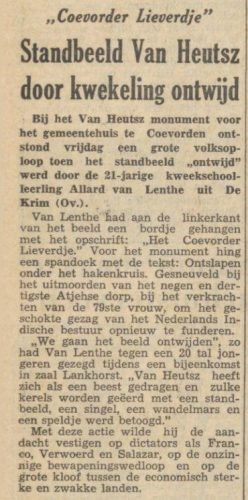
Nieuwsblad van het Noorden, 12 April 1954 (Delpher)
A fast stereotyped around Provo is that this movement actually only occurred in Amsterdam and (possibly) in some other cities in the Randstad. The more beautiful it is that Otten pays ample attention to the publication forms of Provo in the region.
In this way we become acquainted with the ‘Coevorder Lieverdje’, where Drentse Provo’s organized a ‘Happening’ in 1965, and with the expression of Provo in, among others, Groningen and Maastricht.
Happening at the ‘Coevorder Lieverdje’
Drenthe had its own leading Provo, namely Allard van Lenthe. This was very presumably the first Provo who criticized the Vietnam War with a public promotion. In the Drentse Place Coevorden stood a statue of the Indian General and later Governor General Joannes Benedictus van Heutsz (1851-1924), who was born in that place. During the Aceh War (1873-1942) Van Heutsz, like other KliL-leaders and soldiers, was involved in killing civilians.
The Provo’s Allard van Lenthe and Relus ter Beek (1944-2008) – which later became the Queen’s Commissioner in Drenthe – decided that it was time for action and organized early, on April 9, 1965, a happening at the Van Heutsz statue in Coevorden:
“Participants were a handful of teacher training students in the region. They published a magazine for PvdA young people, “De Rooie Drentse.” With their happening, the young Druentaren appointed the killings of villages in Aceh. ” (99)
The analogy that was drawn was naturally related to the Vietnam War. In that war, just like in Aceh, there were innocent civilians victims of the war violence.
Provo’s in the city of Groningen
In June 1966, the first part of the local “Provo leaf Scanda” L appeared in the city of Groningen.
“Due to alleged pornographic poetry (!) The police immediately seized the stock that she found at the raid in the so-called Paranoiashop at Muschengang 5, the headquarters of the Groningen Provo’s.” (129)
After this, the Provo’s went negotiated with the Groningen police commissioner M. Müller. The conversation went better than that of a year earlier, in August 1964, in Amsterdam between the Provo’s there and Chief Commissioner van der Molen:
“Roel van Duijn therefore called the Groningen police chief ‘the first pop-art commissioner in the Netherlands’. Müller agreed to assign the Provo’s a sanctuary for their happeningings: the Martinikerkhof. The presence of a Coulante Chief Chief Commissioner in Groningen was crucial. For example, we can determine that the Groningen police other than the Amsterdam colleagues have never been in the weather with bats and bulletopes. ” (129,130)
Maastricht: Lynx and breakfast in bed
Maastricht showed itself in the hectic pace of Provo a relatively conservative city, that means Marko Otten. According to him, the city was paternalistic, stamped by Roman Catholicism. Bystanders in the city looked surprised during actions, such as during a protest march against NATO in September 1966.
In the city, the political science student Roelof Bos in 1966 put the Provo Pamphlet “Lynx” and breakfast in bed that the Provo culture from Amsterdam had to transfer to Limburg. In the leaf, Maastricht Provo’s acts as Jef van den Hove and Yves van Kempen against war in general and the Vietnam War in particular.
“The last two editions, Lynx 5 and 6, brought the Lynx Pacifism in mid-1967 another battle. Just as we saw that elsewhere in the Provo Publicaions, the editors embraced the ‘Dear (R)evolution’; That became the new subtitle of the leaf. We found the drive for peace here even stronger than before associated with personal choices: Understanding, “Preventive Nonviolent Activity”, Make Love Not War and the rejecting Roman Catholic ethics.”
On the Spui Square in Amsterdam is a statue of the Amsterdam sculptor Carel Kneulman. The Amsterdam Lieverdje (“Litle Darling”) statue represents an Amsterdam Belhamel (“little tramp”) with a big mouth, but a small heart.
On September 10, 1960, the image was revealed but a year and a half before that there was already a plaster variant of which was quickly stolen. A donation of a cigarette manufacturer made it possible to replace it with a bronze copy.
The name:‘t Lieverdje was devised by Henri Knap, he had a column in the daily newspaper Het Parool in which a small street disc made his appearance. A crook that emerged, but which meant it well. The reactions were so positive that pretty more often a story came up with the main character “’t Lieverdje.”
Generation conflict: “to Provo or not to Provo!”
The Provo Movement was established in May 1965 in Amsterdam. With happenings at the statue The Amsterdam sweetheart on the Spui Square and the White Bicycle Plan tried to break small groups of people with the tight pre-war society.
In the stirring sixties, the statue increasingly became the center of protest. Precisely because the image was paid by a cigarette manufacturer, there were protests around the image under the leadership of anti-smoker Robert Jasper Grootveld, against the tobacco industry.
Provo was an anarchist inspired movement that appeared and silently disappeared again. Provo was founded in Amsterdam in 1965 by, among others, Roel van Duijn, Luud Schimmelpennink and Grootveld.
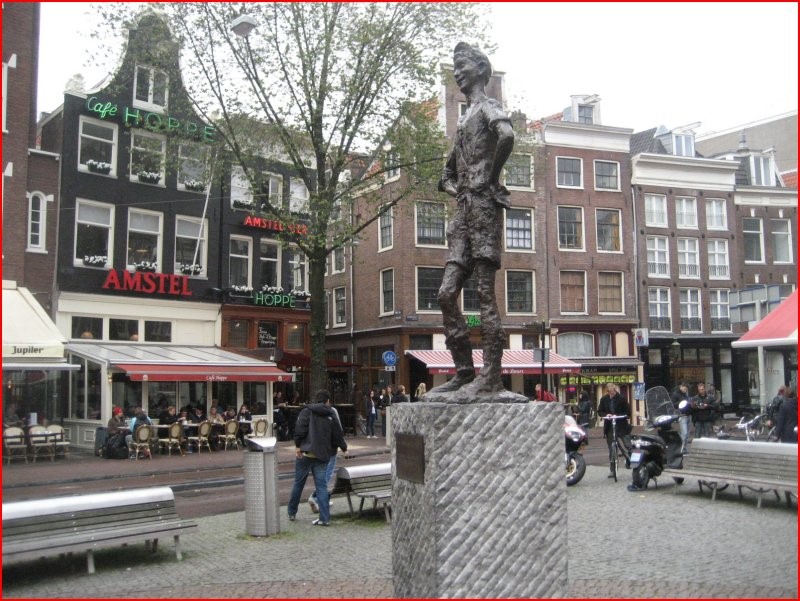
The sweetheart on the Spui Square until today (2021)
The Provo magazine attracted attention among young people from all over the world. Throwing smoke bombs during the marriage of Crown Princess Beatrix and the German Claus von Amsberg with a Nazi pas was one of the most remarkable actions. The ‘mind’ of the movement was criticized to supply society and submit controversial solutions.
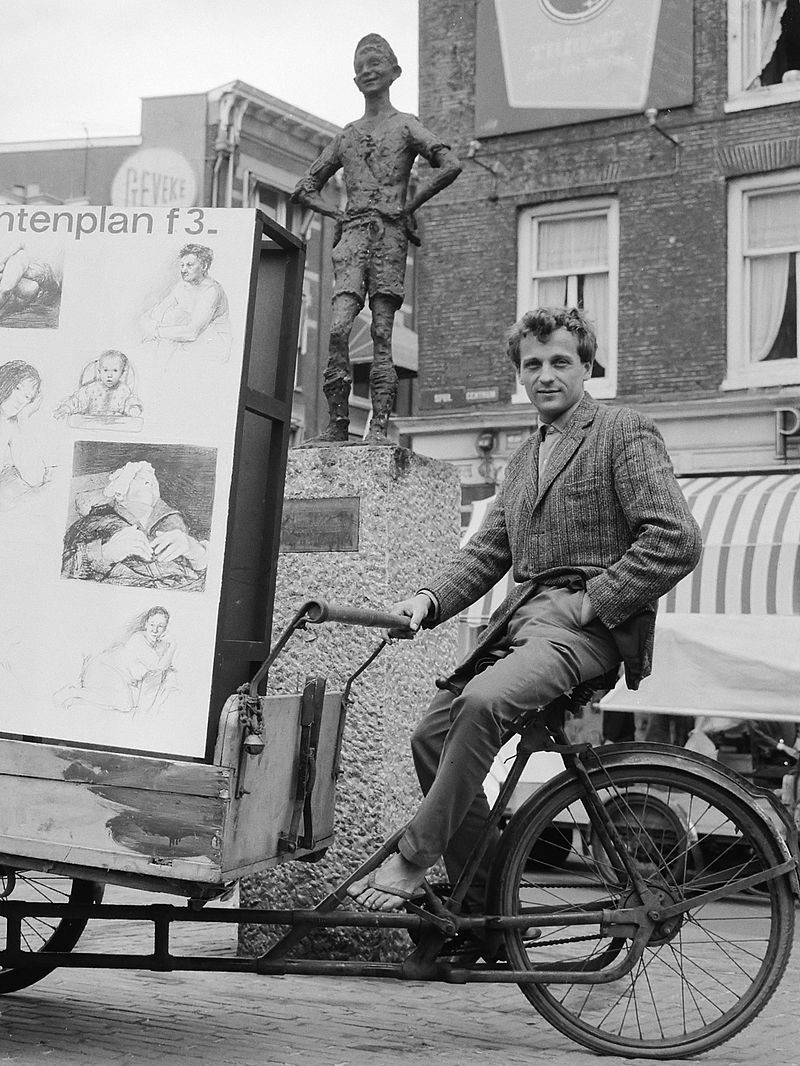
Anti-smoke Magier Robert Jasper Grootveld (1964)
In the early 1970s, Robert Grootveld gives the turn of the national Dutch coffee shop culture by selling openly Marijuana.
Free love, nature, environment, emancipation, renewal, and democratization were the most important topics. In particular, the unorthodox solutions were in the way of a long-lasting success. After two years, the movement was imploding and -symbolic-, Provo was buried in the City’s Vondelpark
Provo’s “The Amsterdam Squat Movement” actually stemmed from the ideas of Provo who have long driven through despite the short existence.
The sweetheart was therefore often the starting point of promotions and center of protest. The image in itself was not that special, where it stood. The average Amsterdam citizen says the image little. Most do not recognize themselves with the ‘image’ of the 60s, 70s and 80s in which ‘Anti’ seemed a magic word ..

Rowdy evens at the Prinsengracht, A policeman being provoked by yearling Provo’s
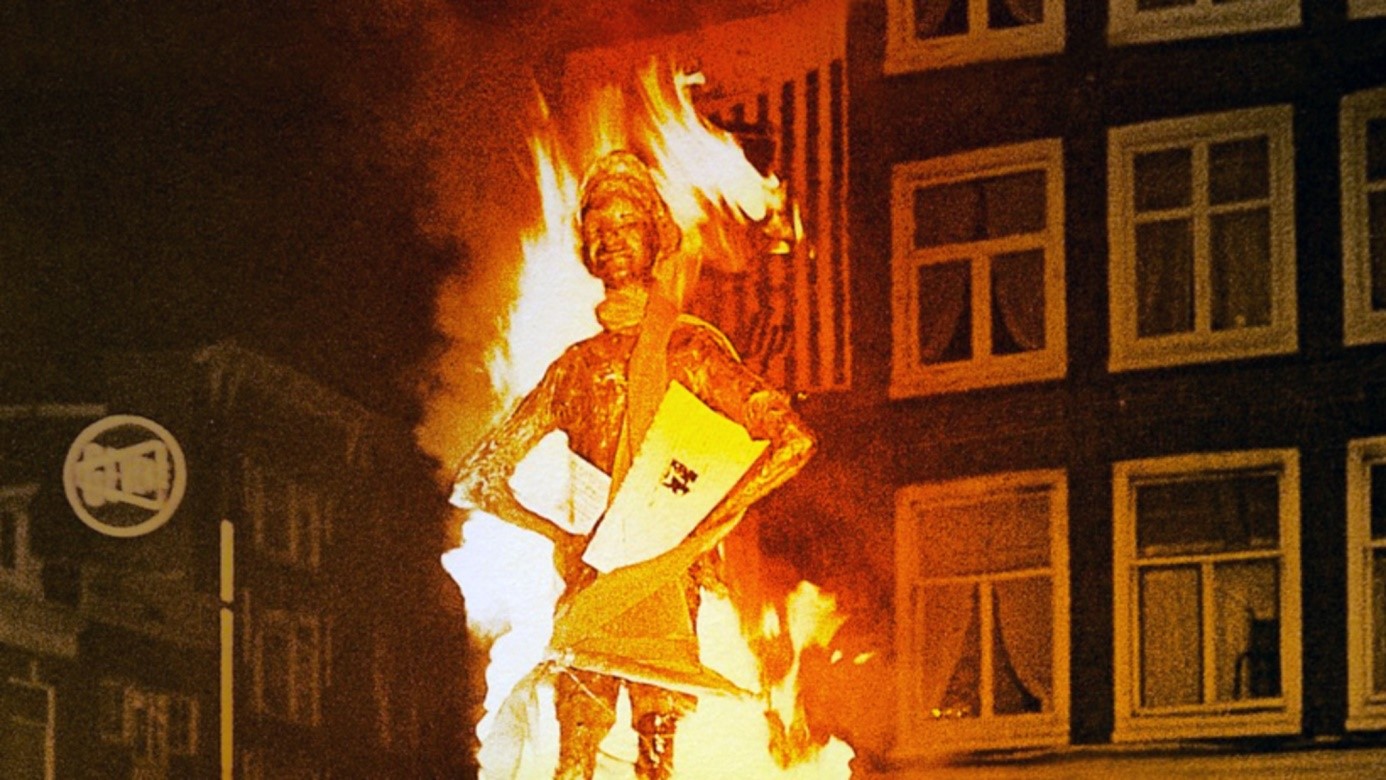
Provo’s at the Lieverdje at the Amsterdamse Spui, March 20, 1966. The statue has an orange sash and was putt to fire. There are fliers on the ground and drums to be heard: truly a provocative “Happening!”
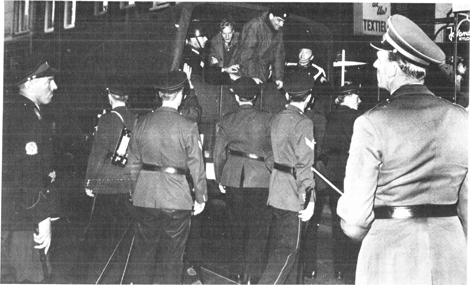
Anti-smoke campaigners were always loud and very provocative and the police always grabbed them away.
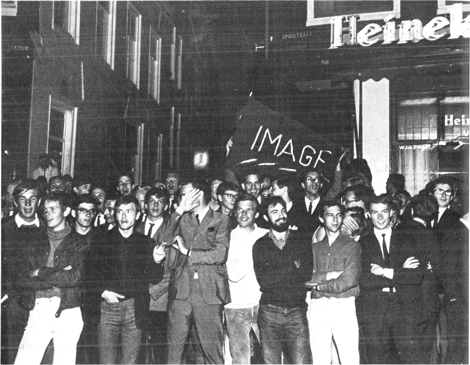
Provo supporters on the Spui during the anti-smoking happening
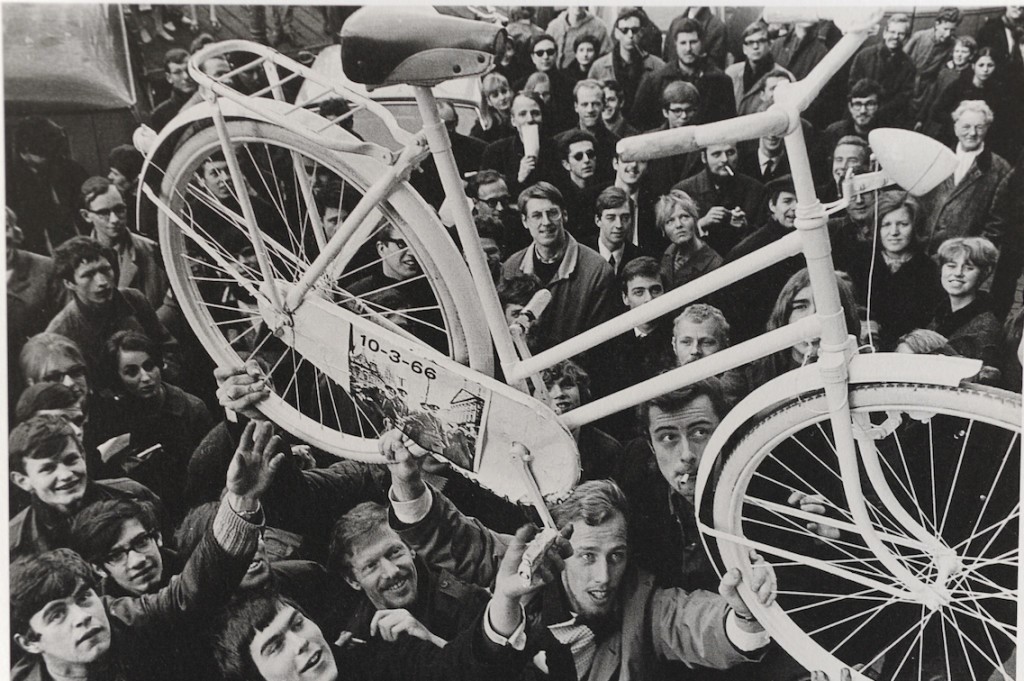
A white bicycle was honored here as a logo for the “White Bicycle Plan.”
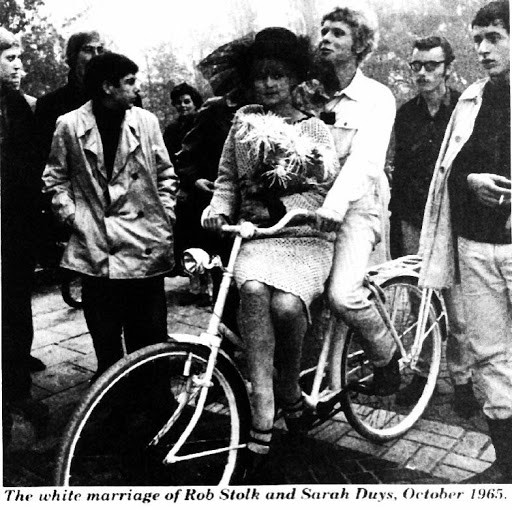
Very different it went a year later with Princess Beatrix, who married Mr. Claus von Amsberg:
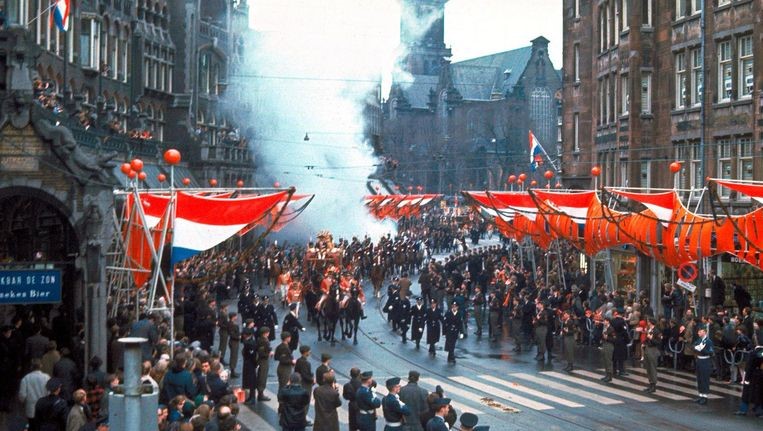
Striking enough, the Provo’s were not only the perpetrators of the smoking bomb incident. However, they did gratefully use all commotion around the Royal Wedding. There was a lot of fuss on the German nationality of Prince Claus, just after the Second World War. His membership of the Hitler Jugend and fighting for the Wehrmacht at the end of the war also contributed to his unpopularity. For the Provo’s, the marriage was the perfect opportunity to profile themselves; to fully benefit their action repertoire and lure the authorities from their tent, as a real PR machine.
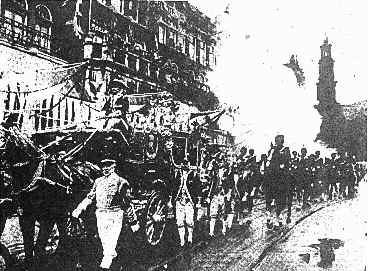
In the golden carriage on the way to the Westerkerk where the royal marriage would take place
Heritage of Provo
Although the Provo has existed only two years, they have left a significant heritage. They ensured that the following generations also went to oppose and devised to the authorities. Examples of this are the Damslapers, the Vondelpark 24/7 project and the hippies. Although the smoke bomb incidents during the marriage of Princess Beatrix and Prince Claus was not immediately caused by Provo it was an important event for the movement. It ensured that they received more attention to their generally playful actions with a deeper, more serious meaning. In more modern 21st century examples, the heritage of Provo can be seen with some empathy. This can be given to the public transport bicycle as a legacy of the white bicycle plan in which the distribution of freely used bicycles is central, although the public transport bicycle is a paid means of transport. The white chimney plan, which meant that air polluters also had to pay for the damage caused, we no longer find any more than normal. The Happenings of Robert Jasper Grootveld against the smoking behavior of the addicted consumer can be seen in the smoking ban in public occasions. Provo may have declared death in 1967, but their ideas have never been lost.
http://www.npo.nl/andere-tijden/05-02-2009/NPS_1121949
https://www.youtube.com/watch?v=Q9nidRdJY80
http://www.npogeschiedenis.nl/andere-tijden/afleveringen/2008-2009/Provo-in-de-pers.html
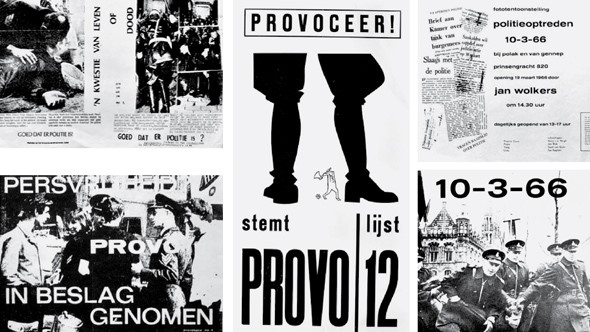
The Amsterdam-based counterculture movement, Provo, first emerged in the city’s Spui Square in 1965 where artist and magician Robert Jasper Grootveld held his ritualistic “happenings” in, as always, a pro-pot, anti-tobacco and advertising-free setting.
Provo began in Amsterdam but it later spread to other cities in the Netherlands, Belgium, Sweden, Germany, a number of Italian cities and even the United States. In the Netherlands of 1965, it quickly became the talk of the town: a youth movement combining art and politics and its actions were shaking up the country. Provo is now considered one of the first major countercultural political movements of the late 1960s.
Provo was named after a term coined by Dutch author Wouter Buikhuisen in a Criminology PhD thesis completed in January 1965. In this study, Buikhuisen uses the word ‘‘provo’’ to refer to one of the subjects of his paper: marginalized groups of young people, street-oriented youth, dropouts or other Dutch equivalents of Britain’s “teddy boys” and France’s ‘‘blousons noirs’’. But make no mistake:
Provo’s motivating force and outlook had little to do with brawling and gang rivalry and its members were not ones for street fighting.
And yet, by choosing the name ‘‘Provo’’ for his movement, Roel Van Duyn, one of Provo’s founding members was sending a firm, openly provocative message of opposition to Dutch society. This came as no surprise given that Provo’s earlier pamphlets were rooted in anarchist thought, were well-versed in the work of Bakunin and poured scorn on the sense of ownership and the Dutch monarchy
From the spring of 1965 to 1967, Provo went from being a small group of members to a large scale movement. Two years after it was set up, the group self-dissolved in May 1967. Though Provo’s years of activity were short-lived they marked a milestone in the history of European protest movements from the second half of the 20th century.
Striking enough, the Provo’s were not only the perpetrators of the smoking bomb incident. However, they did gratefully use all commotion around the Royal Wedding. There was a lot of fuss on the German nationality of Prince Claus, just after the Second World War. His membership of the Hitler Jugend and fighting for the Wehrmacht at the end of the war also contributed to his popularity. For the Provo’s the marriage was the perfect opportunity to profile themselves and to fully benefit their action repertoire and lure the authorities from their tent, as a real PR machine.
Heritage of Provo
Although the Provo Movement itself has existed only two years, they have left a significant heritage. They ensured that the following generations also went to oppose and devised to the authorities. Examples of this are the Damslaapers, the Vondelpark 24/7 project and the hippies. Although the smoke bomb incidents during the wedding of Princess Beatrix and Prince Claus was not immediately caused by Provo it was an important event for the movement. It ensured that they received more attention to their generally playful actions with a deeper, more serious meaning. In more modern 21st century examples, the heritage of Provo can be seen with some empathy. This can be given to the public transport bicycle as a legacy of the white bicycle plan in which the distribution of freely used bicycles is central, although the public transport bicycle is a paid means of transport. The white chimney plan, which meant that air polluters also had to pay for the damage caused, we no longer find any more than normal. The Happenings of Robert Jasper Grootveld against the smoking behavior of the addicted consumer can be seen in the smoking ban in public occasions. Provo may have declared death in 1967, but their ideas have never been lost.
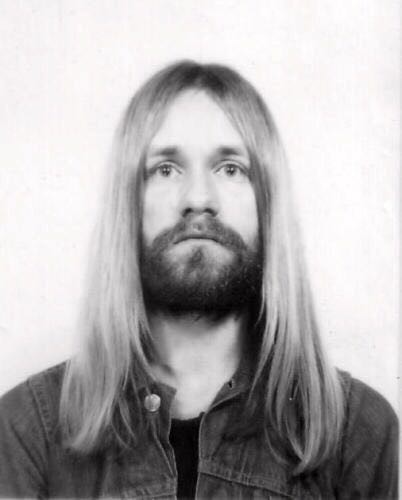
Robert Gorter, MD, as a volunteering medical doctor for the Vondelpark Project 24/7 in 1970-1971
The Vondelpark Project was a combined initiative by the City of Amsterdam and volunteers to provide (practical and medical) support to an estimated 20,000 hippies living / camping 24/7 in the park. The city for instance, provided sanitary facilities, etc.

One of many ponds inside the park
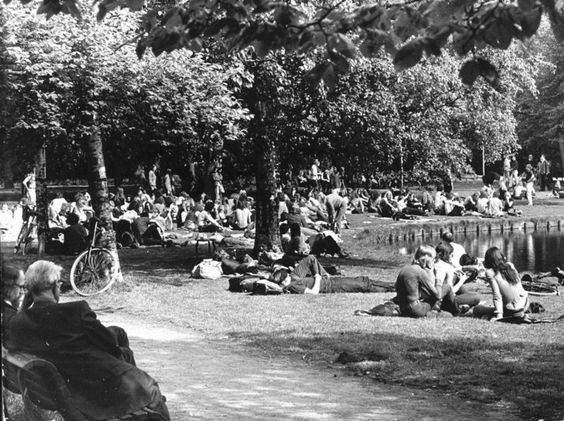
From all over the world, hippies camping in the Amsterdam Vondelpark in 1971 and 1972
The Amsterdam-Based Counterculture Movement, Provo, first emerged in the City’s Spui Square in 1965 Where Artist and Magician Robert Jasper Grootveld HERE HIS Ritualist “Happenings” in, as Always, a pro-pot, anti-tobacco and advertising-free setting.
Provo Began in Amsterdam But It Later Spread to Other Cities in The Netherlands, Belgium, Sweden, Germany, A Number of Italian Cities and Even The United States. In The Netherlands of 1965, IT Quickly Became the Talk of the Town: A Youth Movement Combination Art and Politics and Its Actions Were Shaking Up The Country. Provo is now Considered One of the First Major Countercultural Political Movements of the Late 1960s.
Provo was named After a term coined by Dutch Author Wouter Abdominal Houses in a Criminology PhD thesis completed in January 1965. In this study, abdominal houses Uses the word ” Provo ” to refer to one of the Subjects or His Paper: Marginalized Groups or Young People, Street-Oriented Youth, Dropouts or Other Dutch Equivalents of Britain’s “Teddy Boys” and France’s “blousons noirs.” But Make No Mistake:
Provo’s motivating force and outlook had little to do with brawling and gang rivalry and its members were not the ones for street fighting.
And yet, by choosing the name ” Provo ” for his movement, Roel van Duyn, one of Provo’s founding members was sending a firm, openly provocative message or opposition to Dutch establishment. This came as no surprise given that Provo’s earlier pamphlets were rooted in anarchist thought, were well-versed in the work of Bakunin and poured scorn on the sense of ownership and the Dutch monarchy
From spring 1965 to autumn 1967, Provo went from being a small group of members to a large scale movement. Two years after it was set ip, the group self-dissolved in May 1967. Though Provo’s years of activity were short-lived they marked a milestone in the history of European protest movements from the second half of the 20th Century.
The White Bicycle Plan
Robert Gorter played a constructive role in the “White Bicycle Plan” (Witte Fietsen Plan) with the idea to make available free of charge thousands of white-painted bicycles for clean transportation inside he city borders.
The white bicycle plan was a plan from 1965 to introduce a bicycle system in Amsterdam whereby free white bicycles in collective property would be placed in the city.
It was one of the many white plans, which Provo presented that year. It was intended to tackle the ‘asphalt terror of motorized bourgeoisie’. On July 28, 1965, a leaflet (“Provokatie no. 5”) was distributed during the weekly happening by Robert Jasper Grootveld at the Lieverdje. The first white bicycle – a copy that became white on the spot – was immediately seized by the police because there was no slot on … (Sic).
In 1967, Provo Luud Schimmelpennink came in the Amsterdam city council. He then presented his plan for white bicycles. In Amsterdam, for free bicycles should be available, without a lock, which would be collective possession. Schimmelpennink initially thought of two thousand pieces. To distinguish them from ordinary bicycles they would be painted white.
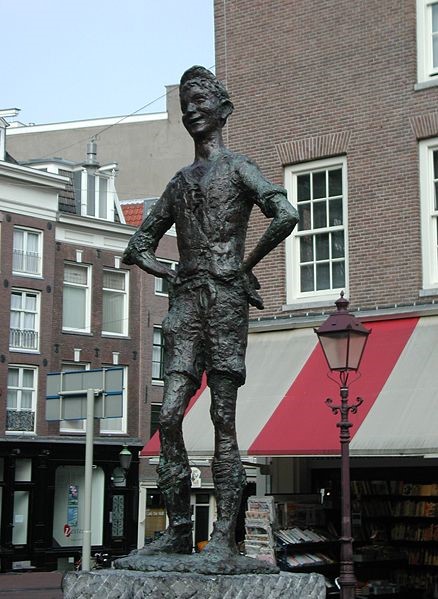
In fact, an already existing situation was legalized. In Amsterdam, many bicycles were stolen for a short ride, left and re-stolen somewhere. Many of these orphans finally disappear in a municipal depot. Schimmelpennink therefore suggested the orphan bikes – whose owner cannot be found – to be able to been painted white.
The city council was not very enthusiastic with the plan did not want to continue. Schimmelpennink then jumped on the development of the “Witkar”, an electrically powered tricycle, which could be rented by participants in the project on a depot for a ride to another depot.
In 2000, a new test was done in Amsterdam with white bicycles, called Depo. This project also came from the sleeve of Schimmelpennink. The bikes, from a very different model, could be borrowed from an automatically managed storage by entering a custom Giropas (chipper) in the storage terminal. The test in which the municipal transport company Amsterdam (GVB) and the Postbank participated were stopped after a few months. Because the stalls were not strong enough, many bicycles were stolen. Plans for a stronger Starling type were rejected by the GVB. Moreover, the number of stalls was too small to let the test succeed.
Test with latest models of White Bikes in 2006

White bicycle
In 2006, another trial took place in Amsterdam in collaboration with public transport bicycle. Following this test, additional rental locations for the public transport bicycle have come in the city center.
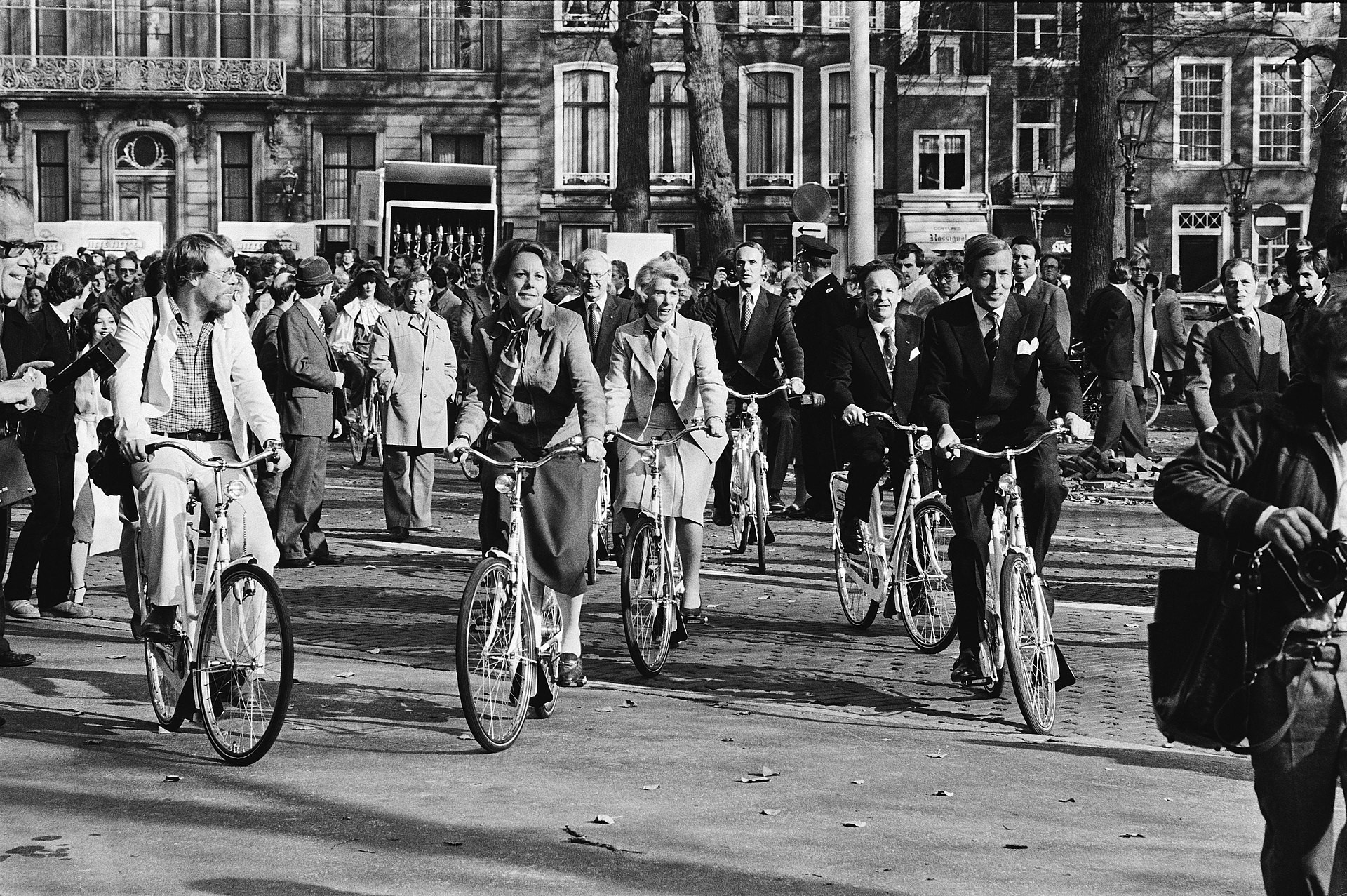
Prince Claus and Minister Kroes on a bicycle of the “white bicycle trailer” of the ANWB and the Dutch Heart Foundation in 1979
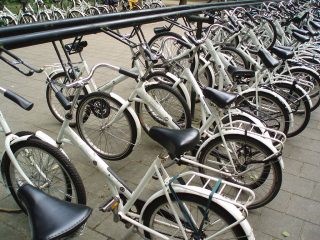
White bicycles in the Veluwe
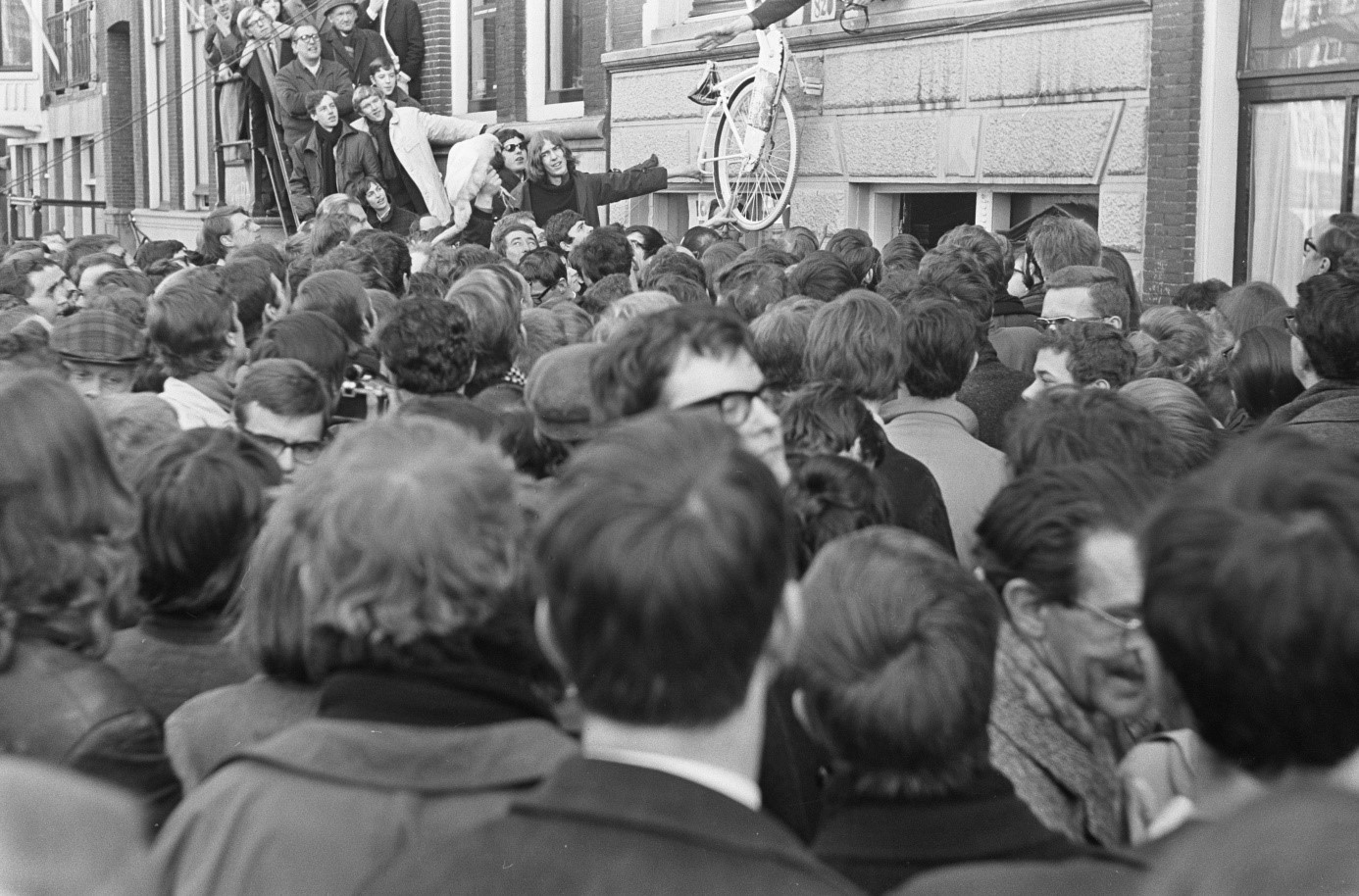
Opening ceremony of the exhibition ‘Because my bike stood there’ in 1966 with a white bicycle as an icon
https://nl.wikipedia.org/wiki/wittefietsen plan
https://www.youtube.com/watch?v=t4dwueqpns0